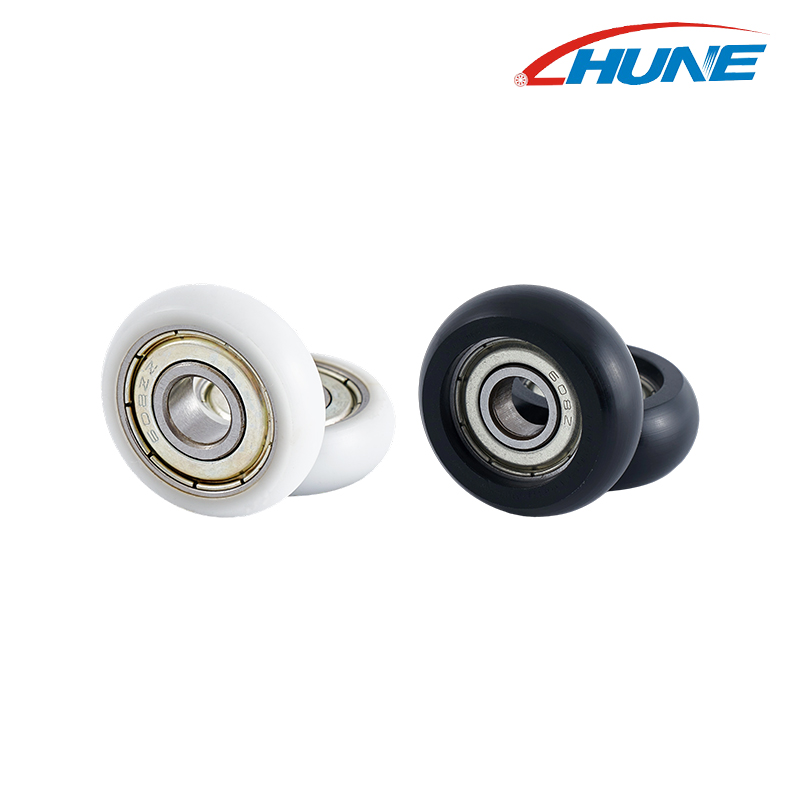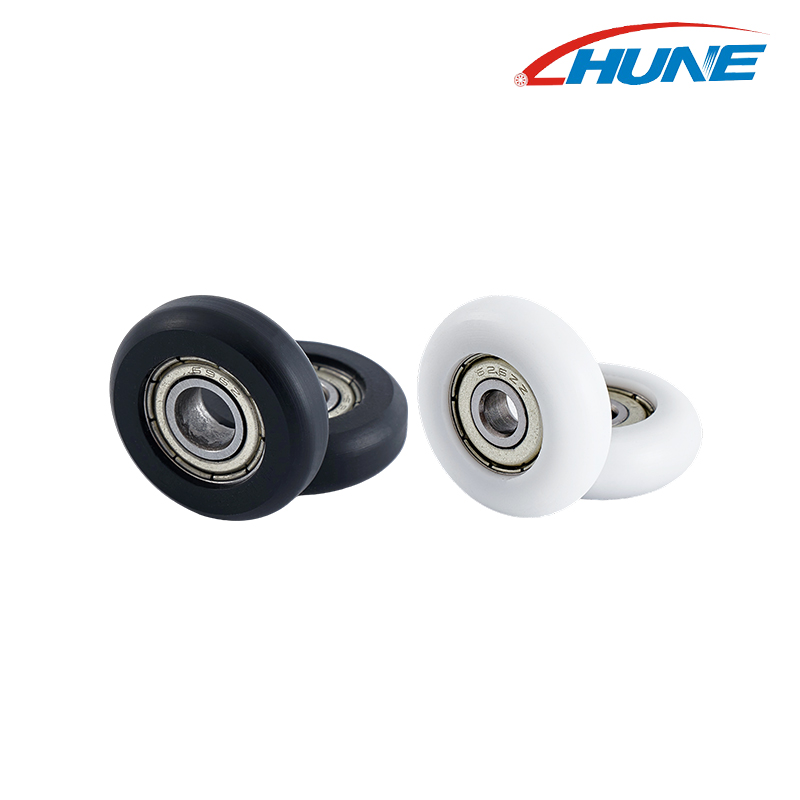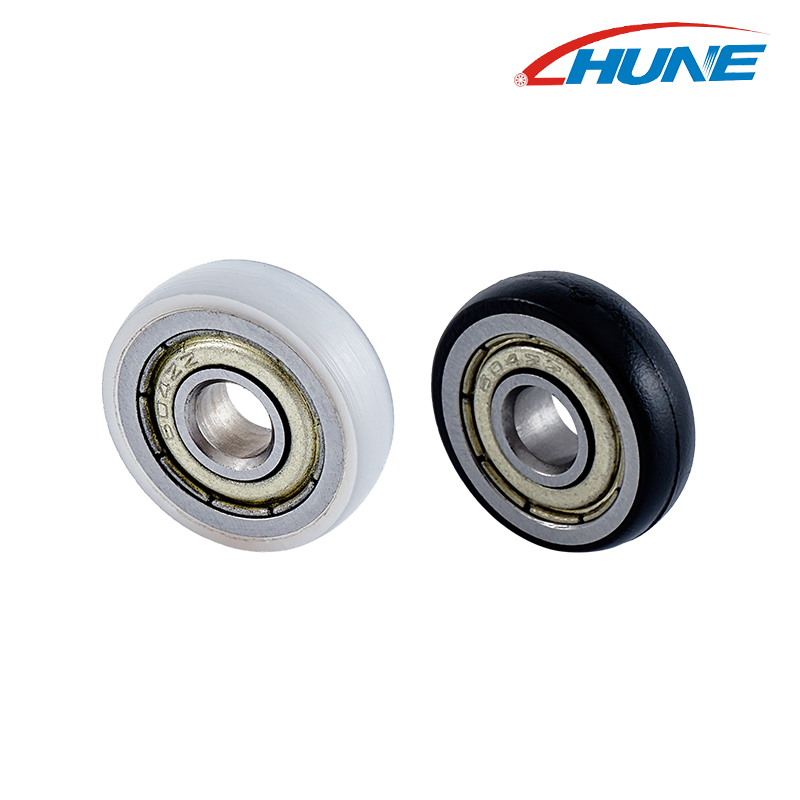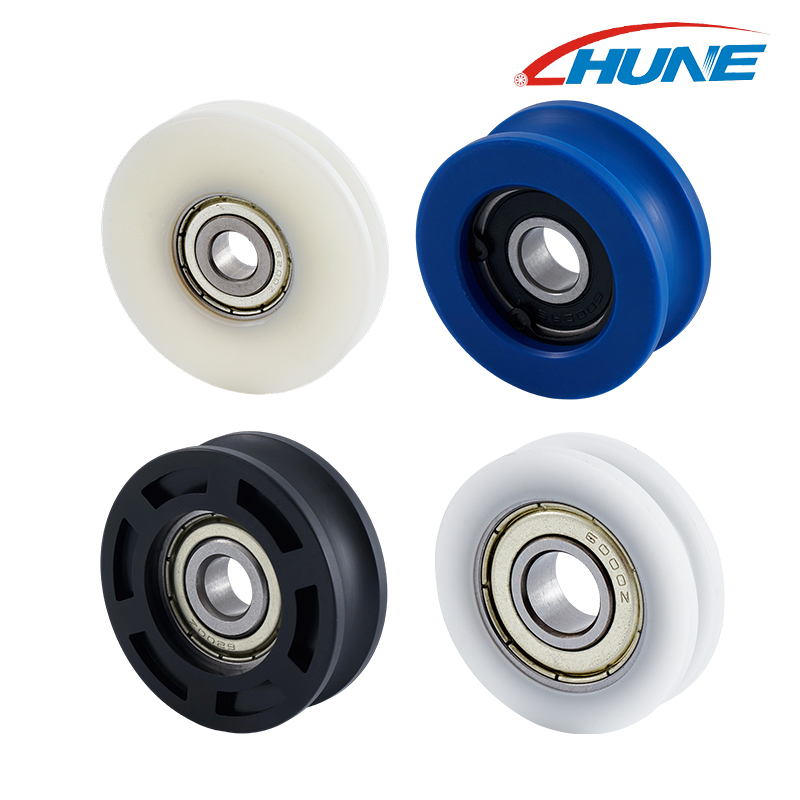What Is a Groove in a Pulley?
A groove in a pulley is a specially designed channel on the pulley wheel that holds and guides a belt, rope, or cable. While it may look like a simple indentation, this groove is critical for the performance, efficiency, and longevity of pulley systems.
What Exactly Is a Groove Pulley Wheel?
A groove pulley wheel is a type of pulley specifically designed with a channel or groove along its circumference. This groove allows a belt, rope, or cable to sit securely, providing enhanced alignment, grip, and torque transmission compared to standard pulleys or roller wheels. Groove pulley wheels are commonly used in mechanical systems where precision, efficiency, and durability are critical.
How It Differs from a Standard Pulley or Roller Wheel
Unlike standard pulleys, which may have a flat surface or minimal contour, groove pulley wheels feature a defined channel that guides the belt or rope. This design reduces slippage, ensures consistent alignment, and allows the system to handle higher loads with better torque efficiency. Roller wheels, often used for sliding or conveyor applications, primarily focus on rolling support and may lack the specialized groove needed for efficient force transmission.
The Basic Working Principle of Groove Pulley Wheels
Motion and Force Transmission
- Groove pulley wheels transmit motion and force by holding the belt or rope securely within the groove. As the pulley rotates, the groove ensures the belt moves smoothly without lateral displacement, maintaining system efficiency.
Physics Behind the Groove Design
- The groove's shape is carefully engineered to optimize alignment, tension, and grip. Proper alignment keeps the belt centered, while the groove's contour enhances friction, preventing slippage even under high tension.
Load and Direction Effects
- The performance of a groove pulley wheel is influenced by the load and direction of force applied. Heavier loads or sudden directional changes require precise groove design to maintain grip and avoid belt misalignment, ensuring consistent torque transmission and operational reliability.
Key Components and Structure of a Groove Pulley Wheel
A groove pulley wheel is made up of several key parts that work together to ensure smooth, reliable operation in a variety of applications.
1. The Wheel Body: Hub, Rim, and Flange
The wheel body forms the core structure of the pulley. It typically consists of three parts:
- Hub: The central part that houses the bearing and connects the pulley to the shaft.
- Rim: The outer edge of the wheel where the groove is formed. The rim provides support to the belt or rope and is crucial for maintaining the pulley’s strength.
- Flange: The raised edge at both ends of the rim that helps keep the belt or rope in the groove, preventing it from slipping off during operation.
2. Groove Profile and Geometry
The groove in a pulley wheel plays a key role in its performance. Different groove profiles are designed for specific applications, including:
- V-groove: A common profile for applications where high tension and load stability are required. It’s effective for maintaining belt alignment and grip.
- U-groove: Typically used for systems with round belts, offering consistent support and minimal slippage.
- Flat groove: Ideal for flat belts, providing a broad contact surface to prevent excessive wear and improve grip.
Each groove geometry is carefully engineered to match the system's needs, ensuring optimal torque transmission and minimal friction.
3. Inner Bearing Setup
The bearing inside the pulley wheel supports smooth rotation by reducing friction at the contact points between the wheel and the axle. The bearings can be ball bearings, roller bearings, or sleeve bearings, depending on the application’s requirements for load capacity and rotational speed.
4. Axle or Mounting Method
The axle or mounting method determines how the groove pulley wheel is fixed in place within the system. Common mounting methods include:
- Set screws: To secure the wheel onto a shaft or axle.
- Keyed connection: For more secure, fixed positioning, preventing slipping between the pulley and shaft.
The axle ensures that the pulley remains stable during operation, contributing to smooth motion transmission.
5. Protective Features
To enhance durability and longevity, many groove pulley wheels come with protective features such as:
- Seals: Prevent contaminants (dust, dirt, moisture) from entering the bearing or groove, extending the pulley's lifespan.
- Caps: Cover the bearings or axle connections to protect against external damage or wear.
- Coatings: Anti-corrosive coatings or surface treatments like galvanization or anodization are often applied to protect the pulley from environmental damage, ensuring optimal performance even in harsh conditions.
Common Groove Types in Pulley Wheels
There are several common groove types used in pulley wheels. Each type is designed for specific uses, making them more efficient for certain tasks.
1. V-Groove Pulley Wheel – For Guided Tracks and Tight Cable Control
- Description: The V-groove pulley wheel features a sharp V-shaped groove, providing precise guidance for belts or cables.
- Advantages: This groove type ensures that the cable or rope stays securely in place, offering high tension stability and minimal slippage.
- Best for: Systems requiring tight control and alignment, such as conveyor belts, mechanical drives, and sliding door systems. The V-shape provides reliable traction even under high load.
2. U-Groove Pulley Wheel – Smoother Cable Movement, Less Wear
- Description: The U-groove pulley wheel has a rounded U-shaped groove that accommodates round cables or ropes.
- Advantages: The U-shaped groove allows for smooth and stable movement of cables, reducing friction and wear. This type of groove is ideal for systems where noise reduction and long-term durability are important.
- Best for: Lifting systems, sliding windows, and elevator cables, where smooth operation and reduced friction are key.
3. Flat Groove Pulley Wheel – For Belts and Light-Load Systems
- Description: The flat groove pulley wheel features a wide, flat groove that is perfect for flat belts.
- Advantages: The flat design ensures even load distribution across the surface of the belt, making it ideal for light-duty applications where high precision is not necessary.
- Best for: Light-duty conveyor systems, furniture applications, and non-critical machinery where load handling is moderate and flexibility is more important than high tension.
4. Double-Groove Pulley Wheel – Dual Drive Transmission
- Description: The double-groove pulley wheel features two grooves, allowing for the simultaneous operation of two belts or cables.
- Advantages: This design enables dual power transmission, making it suitable for systems that require synchronized movement or dual drive capabilities.
- Best for: Multi-drive conveyor systems, synchronized machinery, and dual-cable lifting equipment, where two cables need to run in parallel without interference.
5. Custom Groove Profiles – For Non-Standard Tracks or Ropes
- Description: For applications that require specialized solutions, custom groove profiles can be designed to fit non-standard tracks or ropes.
- Advantages: Custom profiles ensure the perfect fit for specific materials or environments, optimizing performance, durability, and fitment for unique requirements.
- Best for: Industrial systems, specialized lifting equipment, or custom-built machinery where standard grooves do not meet the required specifications.
Types of Grooves in Pulley Wheels: A Comparison
|
Pulley Type |
Description |
Advantages |
Best For |
|
V-Groove Pulley |
V-shaped groove for precise guidance. |
High tension, minimal slippage. |
Conveyors, drives, sliding doors. |
|
U-Groove Pulley |
Rounded groove for round cables. |
Smooth, low friction. |
Lifting, windows, elevators. |
|
Flat Groove Pulley |
Flat groove for flat belts. |
Even load, light-duty. |
Light conveyors, furniture, non-critical machinery. |
|
Double-Groove Pulley |
Two grooves for dual operation. |
Dual transmission. |
Multi-drive systems, synchronized machinery. |
|
Custom Groove Profiles |
Custom grooves for special tracks. |
Optimized fit. |
Industrial, custom machinery. |
Materials Used in Groove Pulley Wheels
The material of a groove pulley wheel is a key factor in its performance, durability, and cost-effectiveness. Different materials are used depending on the application, load requirements, and environmental conditions.
1. Aluminum – Lightweight and Corrosion-Resistant
- Description: Aluminum is a popular choice for groove pulley wheels due to its lightweight and corrosion-resistant properties.
- Benefits: Its low weight makes it ideal for systems where ease of movement is crucial, while its resistance to corrosion ensures durability, especially in humid or indoor environments.
- Best for: Light-duty applications, conveyor systems, and automated machinery where low weight and high resistance to corrosion are essential.
2. Steel – Durable for High-Load or Industrial Systems
- Description: Steel is a strong, durable material commonly used for high-load applications. It is ideal for systems requiring strength and robustness.
- Benefits: Steel's ability to withstand heavy loads, high stress, and abrasion makes it the go-to material for industrial-grade systems. However, it may require additional coatings to prevent corrosion in harsh environments.
- Best for: Industrial systems, high-load conveyors, and heavy-duty machinery where durability and strength are essential.
3. Plastic/Nylon – Low-Noise and Affordable for Home Applications
- Description: Plastic and nylon are lightweight, cost-effective materials often used in non-industrial applications.
- Benefits: These materials offer low-noise operation, making them suitable for environments where sound reduction is a priority. Nylon, in particular, provides low friction, reducing wear and tear on belts or cables.
- Best for: Home applications, sliding doors, and small machinery where cost-effectiveness, low noise, and moderate durability are key.
4. Stainless Steel – Ideal for Marine or Outdoor Use
- Description: Stainless steel is highly resistant to corrosion and rust, making it the material of choice for outdoor and marine environments.
- Benefits: Its ability to withstand extreme weather conditions, moisture, and salt exposure makes it perfect for marine rigging, outdoor equipment, and systems exposed to harsh environments.
- Best for: Marine systems, outdoor lifting equipment, and harsh industrial environments where resistance to corrosion and extreme weather is crucial.
Materials Used in Groove Pulley Wheels: A Comprehensive Overview
|
Material |
Description |
Benefits |
Best For |
|
Aluminum |
Lightweight, corrosion-resistant. |
Easy movement, durable. |
Light-duty conveyors, automation. |
|
Steel |
Strong, durable. |
High load capacity, may need corrosion coatings. |
Industrial, heavy-duty systems. |
|
Plastic/Nylon |
Lightweight, low-noise. |
Affordable, reduces friction. |
Home use, sliding doors, small machines. |
|
Stainless Steel |
Corrosion-resistant. |
Withstands harsh weather. |
Marine, outdoor, harsh environments. |
How Material Selection Affects Longevity and Friction
The material of a groove pulley wheel affects both its longevity and friction levels. For example, steel and stainless steel are more durable and can handle higher loads, but they may create more friction compared to lighter materials like aluminum or plastic. Aluminum offers a good balance between weight and durability, making it ideal for lighter applications. Meanwhile, plastic and nylon pulleys are quieter and create less friction, but they may wear out faster under heavy loads.
Manufacturing and Surface Treatment of Groove Pulley Wheels
The manufacturing process and surface treatment of groove pulley wheels play a crucial role in ensuring their performance, durability, and resistance to wear.
1. Precision CNC Machining for Perfect Groove Alignment
- Process: CNC (Computer Numerical Control) machining ensures that each groove is cut with high precision, maintaining perfect alignment and consistency across all pulleys.
- Benefit: This guarantees smooth operation, reduces friction, and prevents the belt or rope from slipping off during use.
2. Heat Treatment for Strength and Hardness
- Process: Heat treatment involves heating the pulley wheel to a specific temperature and then cooling it rapidly. This process strengthens the material, improving its hardness and ability to withstand heavy loads.
- Benefit: Enhanced durability and performance, especially for pulleys used in high-load or industrial applications.
3. Anodizing, Zinc Plating, or Powder Coating for Anti-Rust Protection
- Process: Surface treatments like anodizing, zinc plating, or powder coating are applied to protect the pulley wheel from corrosion and environmental damage.
- Benefit: These treatments provide a protective layer that resists rust, wear, and environmental elements, extending the pulley’s lifespan, particularly in outdoor or marine environments.
4. Balancing and Testing Before Assembly
- Process: After manufacturing, the pulley is carefully balanced to ensure smooth and stable rotation. Rigorous testing is conducted to check for any defects or performance issues.
- Benefit: Ensures that the pulley operates without wobbling, reducing wear and tear and improving overall system efficiency.
Overview of Manufacturing and Surface Treatment for Groove Pulley Wheels
|
Process |
Benefit |
|
CNC Machining |
Precision groove alignment for smooth, slip-free operation. |
|
Heat Treatment |
Strengthens material, improving durability and load capacity. |
|
Anti-Rust Treatment |
Anodizing or coating for corrosion resistance, extends lifespan. |
|
Balancing and Testing |
Ensures smooth rotation and reduces wear through balancing and defect testing. |
Applications of Groove Pulley Wheels
Groove pulley wheels are widely used in various industries and systems due to their ability to efficiently transmit motion and handle loads.
1. Sliding Doors and Windows
- Use: Groove pulley wheels are often found in sliding door and window systems, allowing smooth and silent movement.
- Benefit: They help reduce friction, ensuring easy operation in both residential and commercial settings.
2. Garage and Industrial Doors
- Use: These pulleys are crucial in garage doors and industrial rolling doors, where they support heavy panels or gates.
- Benefit: Groove pulleys provide strength, alignment, and smooth operation for doors under frequent use or heavy loads.
3. Conveyor Systems and Machinery
- Use: Groove pulley wheels are an essential part of conveyor belts and various industrial machinery.
- Benefit: They help transfer power effectively, enabling smooth material handling in manufacturing, packaging, and distribution systems.
4. Fitness and Lifting Equipment
- Use: Many fitness machines, such as weightlifting pulleys and resistance training equipment, use groove pulleys.
- Benefit: These pulleys allow smooth, controlled movement of cables or ropes, enhancing workout efficiency and safety.
5. Cable Systems and Elevators
- Use: Groove pulleys are used in cable systems, including elevators, to guide and support the cables or ropes.
- Benefit: They ensure smooth, reliable motion, preventing slippage and reducing wear on cables during vertical lifts.
6. Robotics and Automation
- Use: In robotics and automated systems, groove pulleys help drive and guide mechanical arms, wheels, and other moving components.
- Benefit: The pulleys enable precise control and movement, crucial for tasks requiring high accuracy.
7. Marine Rigging and Hoisting Systems
- Use: Groove pulleys are commonly found in marine rigging and hoisting systems, including sailboats and cranes.
- Benefit: They help manage heavy loads and provide smooth movement of ropes and cables, essential for safety and efficiency in maritime operations.
Groove Pulley Wheels in Various Applications
|
Application |
Use |
Benefit |
|
Sliding Doors and Windows |
Smooth movement in sliding systems. |
Reduces friction. |
|
Garage and Industrial Doors |
Supports heavy panels. |
Ensures strength and smooth operation. |
|
Conveyor Systems and Machinery |
Key for conveyors and machinery. |
Smooth power transfer. |
|
Fitness and Lifting Equipment |
In weightlifting and resistance machines. |
Smooth cable movement. |
|
Cable Systems and Elevators |
Guides cables in elevators. |
Smooth, reliable motion. |
|
Robotics and Automation |
Guides robotic components. |
Precise control. |
|
Marine Rigging and Hoisting Systems |
In marine and crane systems. |
Manages heavy loads smoothly. |
Advantages of Groove Pulley Wheels
Groove pulley wheels offer numerous benefits that make them ideal for a wide range of applications.
1. Smooth and Stable Motion Control
- Benefit: Groove pulley wheels help maintain consistent movement, reducing vibrations and instability.
- Why it Matters: This ensures smooth operation, whether in a conveyor system or a sliding door, enhancing the overall performance and reliability of the system.
2. Reduced Cable or Belt Slippage
- Benefit: The groove design securely holds the belt or rope in place, preventing unwanted slippage.
- Why it Matters: This improves efficiency and safety, ensuring that the system operates without interruptions or loss of power transmission.
3. Noise Reduction and Wear Resistance
- Benefit: The groove profile helps minimize friction between the pulley and belt, resulting in quieter operation and reduced wear.
- Why it Matters: Less noise and wear lead to longer system lifespans and more comfortable environments, especially in residential or commercial settings.
4. High Efficiency with Minimal Maintenance
- Benefit: Groove pulley wheels are designed for maximum power transmission efficiency with minimal friction.
- Why it Matters: The reduced friction and wear help extend the life of both the pulley and belt, lowering maintenance costs and downtime.
5. Compact Design and Versatile Mounting Options
- Benefit: Groove pulley wheels are available in a range of sizes and can be mounted in various configurations, offering flexibility in design.
- Why it Matters: This compactness allows for easier integration into tight spaces, making them suitable for a variety of applications, from small machines to large industrial systems.
Key Advantages of Groove Pulley Wheels
|
Advantage |
Benefit |
Why It Matters |
|
Smooth Motion Control |
Reduces vibrations. |
Ensures reliable operation. |
|
Reduced Slippage |
Holds belts securely. |
Enhances efficiency and safety. |
|
Noise & Wear Resistance |
Minimizes friction and noise. |
Increases lifespan and comfort. |
|
Efficiency & Low Maintenance |
Efficient power transfer. |
Cuts maintenance costs. |
|
Compact & Versatile |
Multiple sizes and mounts. |
Fits tight spaces, adaptable. |
Groove Pulley vs. Flat Pulley: What's the Difference?
Both groove pulleys and flat pulleys serve the same basic function of transmitting motion, but their design differences make them suitable for different applications.
1. Groove Design for Controlled Path vs. Flat Pulley for Free Belt Motion
Groove Pulley:
- The groove in a pulley creates a controlled path for the belt or rope, ensuring that it stays securely aligned during operation. This design is ideal for systems where precision and stability are important. The groove guides the belt, preventing slippage and ensuring that the system works efficiently, even under high tension.
Flat Pulley:
- In contrast, a flat pulley has a smooth, flat surface that allows the belt or rope to move freely without any specific guidance. This is useful in applications where flexibility and ease of movement are prioritized, and precise alignment is not as critical.
2. Efficiency and Load-Handling Comparison
Groove Pulley:
- Groove pulleys generally offer higher efficiency in systems requiring high torque and load handling. The groove design increases friction and grip between the pulley and the belt or rope, reducing slippage and improving the transmission of force. This makes groove pulleys ideal for high-load systems and applications where precise motion control is essential, such as conveyor belts or lifting equipment.
Flat Pulley:
- While flat pulleys can handle lighter loads, they are less effective in high-load situations. Their design allows for free belt motion, which can lead to slippage under heavy tension, reducing efficiency. Flat pulleys are best suited for low-load applications or when precise control is not as critical, such as small machinery or basic conveyor systems.
3. Application-Specific Advantages
Groove Pulley:
Groove pulleys are the go-to choice for applications where controlled motion, high efficiency, and load handling are required. Some common applications include:
- Conveyor Systems: Ensuring stable belt movement under heavy loads.
- Lifting Equipment: Offering precise control for lifting and hoisting operations.
- Sliding Doors: Ensuring smooth and controlled movement for heavy or large doors.
Flat Pulley:
Flat pulleys, while less specialized, excel in applications where flexibility and low-load handling are more important. They are commonly used in:
- Basic Conveyor Systems: Where load demands are lower and movement flexibility is more important than precision.
- Home and Light-Duty Applications: Such as in furniture systems or basic machinery where a non-precise belt path is acceptable.
- Pulleys for Lightweight Systems: Where the focus is on simplicity and ease of motion rather than load-bearing capability.
Groove Pulley vs. Flat Pulley: A Detailed Comparison
|
Pulley Type |
Design |
Efficiency & Load |
Applications |
|
Groove Pulley |
Guides belt precisely. |
High efficiency, handles heavy loads. |
For conveyors, lifting, sliding doors. |
|
Flat Pulley |
Allows free movement. |
Best for light loads. |
For light-duty, flexible systems. |
Common Misconceptions
1. “All Pulleys Are the Same” – Debunked
Not all pulleys are created equal. The type of pulley you choose depends on your specific application. Groove pulleys provide more control and efficiency, while flat pulleys are better suited for less demanding tasks. Choosing the right pulley can make a significant difference in system performance.
2. Groove Depth Doesn't Equal Strength
A deeper groove doesn't necessarily mean a stronger pulley. The strength of a groove pulley depends on the material, design, and application. A shallow groove can be just as effective for light-load applications, whereas a deeper groove is used in high-load, high-torque scenarios.
3. Why Cheap Pulleys Often Fail Early
Cheap pulleys are often made from low-quality materials and lack precision in manufacturing. This can lead to premature wear, increased friction, and failure. It’s important to invest in high-quality pulleys designed for the specific load and environment to ensure longevity and performance.
Selecting the Right Groove Pulley Wheel
Choosing the right groove pulley wheel is essential for ensuring smooth operation, longevity, and reliability in your system. Several factors must be taken into account to select the best pulley wheel for your application.
1. Factors to Consider
- Load Capacity
- The load capacity of the pulley wheel is critical for ensuring it can withstand the weight and tension of the system without failure. For heavy-duty applications, select pulleys designed for higher load capacities to maintain system stability and prevent premature wear.
- Diameter
- The diameter of the pulley influences both the speed and torque of the system. Larger diameter pulleys provide better torque transmission, which is ideal for heavy-duty systems. Smaller diameter pulleys are more suited for high-speed applications, where quick movement is a priority.
- Groove Type
- Different groove types provide various benefits depending on the type of belt or cable used. V-grooves offer precise alignment for high-tension systems, while U-grooves are suited for round cables, and flat grooves work best with flat belts. Choose a groove type that aligns with your system's belt or cable requirements.
- Bearing Type
- The bearing type plays a key role in the smooth rotation of the pulley. Different bearing types (ball bearings, roller bearings, or sleeve bearings) provide varying levels of friction, load capacity, and speed. Select a bearing type that balances friction and load requirements for your system's specific needs.
2. How to Match Groove Profile with Cable or Belt
- V-Groove: Ideal for belts or ropes that require precise control and tight alignment, such as conveyor systems. The groove ensures that the belt remains centered, reducing slippage and maintaining torque transfer.
- U-Groove: Perfect for round cables or ropes that need smooth and stable movement. The U-shaped groove ensures the cable stays in place while minimizing wear and friction.
- Flat Groove: Works well with flat belts, providing a broad surface area for load distribution and reducing wear in light-duty applications. This groove is suitable for non-critical systems where alignment is less of a concern.
3. Environmental Factors
- Moisture: If the pulley will be exposed to moisture, opt for materials that are resistant to rust and corrosion, such as stainless steel or pulleys with corrosion-resistant coatings.
- Temperature: Extreme temperatures can affect material strength and flexibility. Choose pulleys made from materials that can withstand high or low temperatures without deforming or losing efficiency.
- Corrosion Resistance: For outdoor or marine applications, corrosion resistance is a top priority. Pulleys made of stainless steel or those with protective coatings like zinc plating or anodizing will ensure long-term durability in challenging environments.
4. Compatibility with Existing Hardware or Frame
- Before choosing a groove pulley wheel, ensure that it is compatible with your existing hardware or frame. Pay attention to:
- Mounting Method: Make sure the pulley's mounting options are suitable for your setup (e.g., set screws, keyed connections, or flanged designs).
- Size and Dimensions: The pulley wheel must fit seamlessly into your system's frame or shaft. Ensure that the diameter, width, and groove depth match the belt or cable specifications.
Reliable Manufacturer Support — Hune Groove Pulley Wheel Factory
For businesses seeking high-precision, durable groove pulley wheels, Hune Groove Pulley Wheel Factory offers comprehensive manufacturing solutions, including:
- Expert Engineering: Custom groove profiles and bearing systems tailored to your specifications.
- Advanced CNC Machining: High-precision manufacturing to ensure perfect groove alignment and reliable performance.
- OEM & ODM Production: Fast turnaround times for both standard designs and custom-engineered pulleys.
- Global Delivery & Responsive Support: Reliable shipping and dedicated technical support to ensure smooth operations.
Whether you need standard designs or custom-engineered solutions, Hune Groove Pulley Wheel Factory guarantees smooth operation, long-lasting durability, and consistent performance across a wide range of applications.






 English
English  Español
Español  日本語
日本語 









